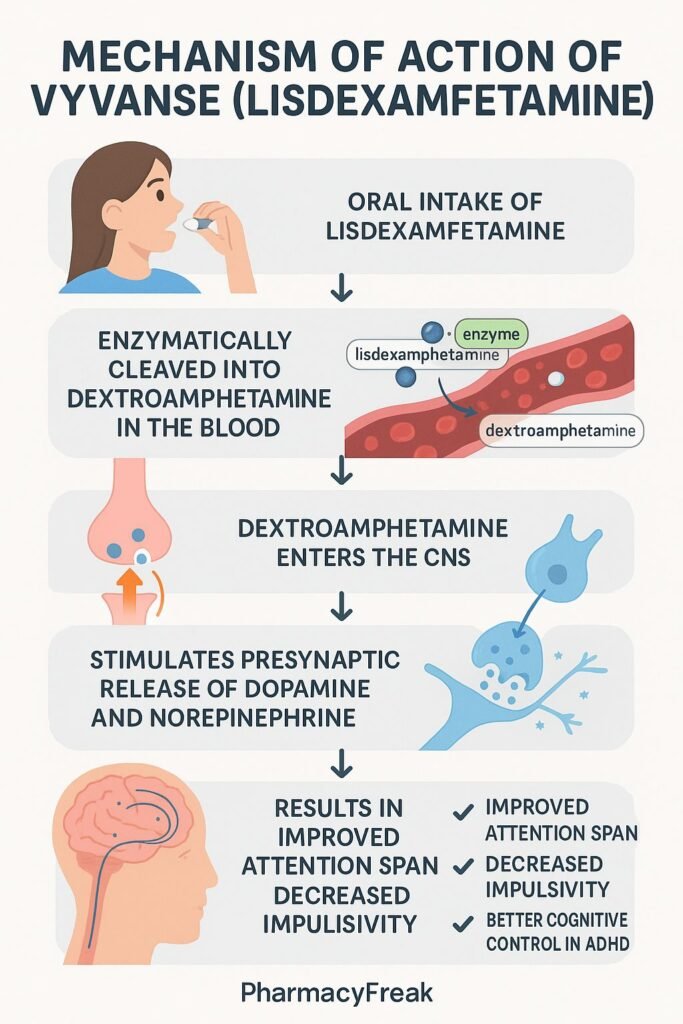Table of Contents
Introduction
Vyvanse (lisdexamfetamine) is a central nervous system stimulant used to treat ADHD and binge-eating disorder. It is a prodrug, meaning it becomes active only after enzymatic conversion in the body. This mechanism provides a smoother onset, extended action, and lower risk of misuse. Its active metabolite, dextroamphetamine, boosts dopamine and norepinephrine in the brain—improving attention, control, and cognitive function.
Step-by-Step Mechanism of Action
- Enzymatic Conversion
After oral intake, lisdexamfetamine is hydrolyzed in red blood cells into dextroamphetamine and L-lysine. - Reuptake Inhibition
Dextroamphetamine blocks dopamine (DAT) and norepinephrine (NET) transporters, increasing their concentration in synapses. - VMAT2 Disruption
It promotes the release of monoamines from vesicles via vesicular monoamine transporter 2 (VMAT2). - TAAR1 Activation
Stimulates trace amine-associated receptor 1 (TAAR1), altering neurotransmitter dynamics and reinforcing stimulant action. - Therapeutic Effect
Elevated dopamine and norepinephrine levels improve focus, attention, behavioral control, and appetite suppression.

Pharmacokinetic Parameters
| Parameter | Value |
|---|---|
| Bioavailability | ~96% (oral) |
| Half-life (Prodrug) | Less than 1 hour |
| Half-life (Active Drug) | 10–12 hours (dextroamphetamine) |
| Onset of Action | 1.5–2 hours (may be delayed by food) |
| Duration of Effect | 10–14 hours |
| Protein Binding | ~20% |
| Metabolism | Hydrolysis in RBCs, followed by hepatic steps |
| Excretion | Primarily renal (~2% unchanged) |
Clinical Uses
- Attention-Deficit/Hyperactivity Disorder (ADHD)
- Binge-eating disorder (adults only)
Adverse Effects
- Decreased appetite
- Insomnia, restlessness
- Elevated heart rate and blood pressure
- Gastrointestinal discomfort
- Anxiety, mood swings
- Risk of dependence (Schedule II)
- Rare: psychosis, mania, cardiovascular events
Comparative Analysis
| Feature | Vyvanse | Adderall |
|---|---|---|
| Activation | Prodrug (enzymatic step) | Immediate-release amphetamines |
| Onset | 1.5–2 hours | <1 hour |
| Duration | 10–14 hours | 4–6 h (IR), 10–12 h (XR) |
| Abuse Potential | Lower | Higher |
| Dosing | Once daily | IR multiple doses, XR once daily |
MCQs
1. How is Vyvanse activated in the body?
A. Direct DAT inhibition
B. Hydrolysis by red blood cells into dextroamphetamine
C. Hepatic CYP metabolism
D. Passive diffusion
Answer: B
2. Which neurotransmitters are increased by Vyvanse?
A. Serotonin
B. Dopamine and norepinephrine
C. GABA and glutamate
D. Acetylcholine
Answer: B
3. Which transporters are inhibited by the active form of Vyvanse?
A. SERT only
B. DAT and NET
C. GABA transporter
D. None
Answer: B
4. What is the average duration of Vyvanse’s effect?
A. 3–4 hours
B. 6–8 hours
C. 10–14 hours
D. Over 24 hours
Answer: C
5. Compared to Adderall, Vyvanse has:
A. Faster onset
B. Lower abuse potential
C. Shorter duration
D. Higher peak plasma levels
Answer: B
6. The half-life of dextroamphetamine is approximately:
A. 2–4 hours
B. 10–12 hours
C. 1 hour
D. 24 hours
Answer: B
7. What receptor does Vyvanse indirectly activate?
A. GABA-A
B. NMDA
C. TAAR1
D. 5-HT3
Answer: C
8. A typical side effect of Vyvanse includes:
A. Increased appetite
B. Bradycardia
C. Insomnia
D. Hypotension
Answer: C
9. Vyvanse is legally classified as:
A. Schedule IV
B. Over-the-counter
C. Schedule II controlled substance
D. Prescription only, not scheduled
Answer: C
10. Its benefit in binge-eating disorder is mainly due to:
A. Mood stabilization
B. Sedation
C. Appetite suppression via increased dopamine
D. Serotonin inhibition
Answer: C
FAQs
1. Is Vyvanse a prodrug?
Yes, it is enzymatically converted in red blood cells to dextroamphetamine.
2. How fast does it work?
Usually 1.5 to 2 hours after administration. Food can delay the onset.
3. Can Vyvanse be used for weight loss?
No. Although it reduces appetite, it is not approved for weight management.
4. Is Vyvanse addictive?
Yes. It is classified as a Schedule II controlled substance, but its prodrug form lowers the risk of abuse compared to other stimulants.
5. When should Vyvanse be taken?
In the morning, to avoid insomnia due to its long duration of action.
Related Links
References
- NCBI – Lisdexamfetamine Clinical Overview
- PubMed – Vyvanse Pharmacokinetics
- FDA Prescribing Information – Vyvanse
- Goodman & Gilman’s: The Pharmacological Basis of Therapeutics
- Lexicomp Drug Monograph – Lisdexamfetamine

I am pursuing MBA in pharmaceutical management from NIPER Hyderabad with a strong academic record and proven success in national-level pharmacy entrance exams. I secured AIR 61 in NIPER 2024 (MS/M.Pharm) and AIR 27 in NIPER MBA, along with AIR 147 in GPAT 2024 and AIR 907 in GPAT 2023. I also achieved AIR 6 in AIIMS CRE-2025 for Drug Store Keeper and was selected as a Pharmacist (AIR 61) for ESIC. Additionally, I was the Runner-Up in Round 2 of the EY Case Study Competition.
At PharmacyFreak.com, I aim to guide future pharmacists through expert content, exam strategies, and insightful resources based on real experience and academic excellence.
Mail- harsh@pharmacyfreak.com
